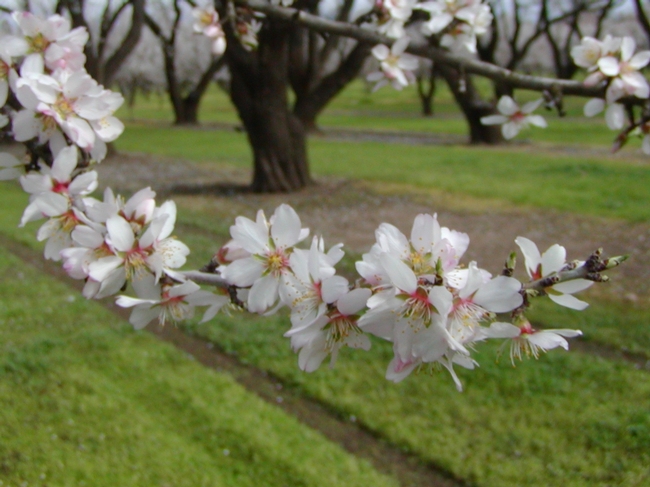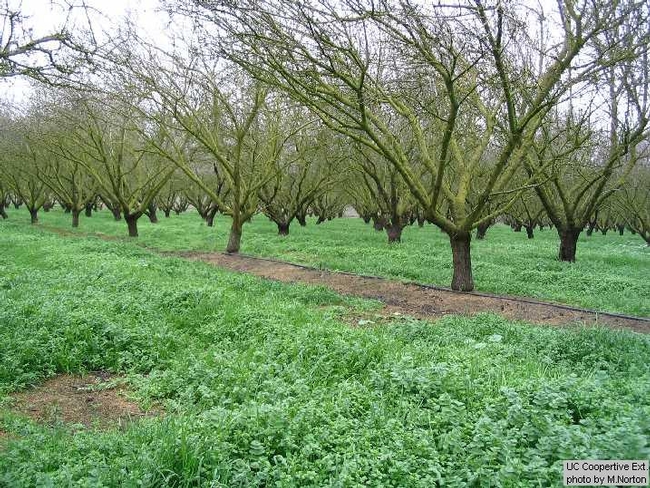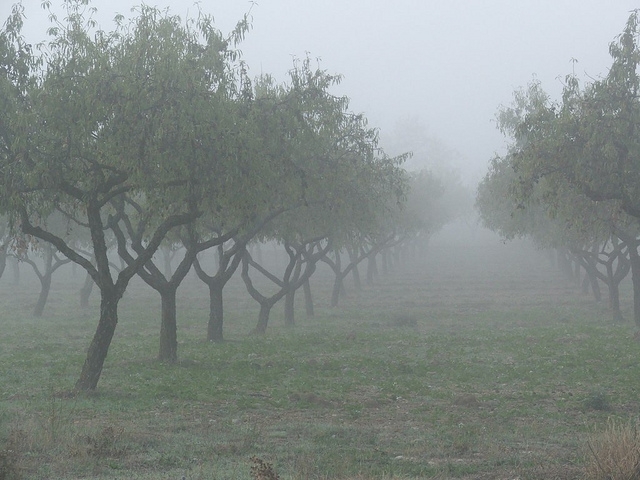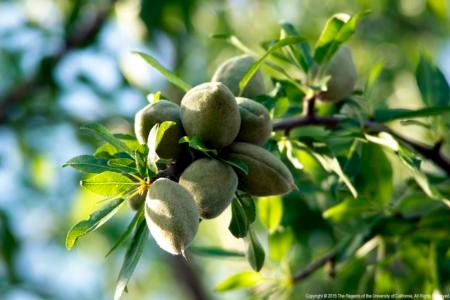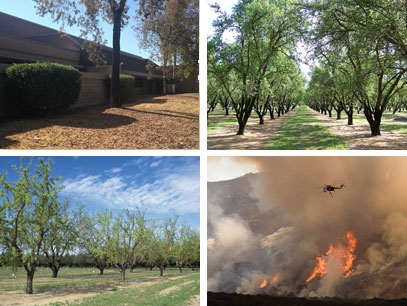Posts Tagged: David Doll
Almond prices dip as global demand plunges
Despite the state's four-year drought, almond production continued its steady rise over the last 15 years. The plunge in global demand may impact the trend, according to UC Agriculture and Natural Resources Cooperative Extension advisor David Doll. Last year Philpott asked Doll how long the almond boom would continue.
"He told me it would only stop 'when the crop stops making money,'" Philpott wrote.
Doll explained that, under normal water supply conditions, the break-even farmer price for almonds is $1.45 per pound. But when water is scarce and farmers pay more for water, the break-even price rises to $2.60 to $2.85 per pound. The Fresno Bee this month reported that almond prices dropped about 20 percent to $2.50 to $2.75 per pound.
Growers are hoping that El Niño will reduce water costs and that the Asian and European appetite for almonds returns to normal, pushing up the almonds' value once again.
Ezra David Romero of Valley Public Radio reported that the strength of the U.S. dollar also reduced buyer interest in California almonds.
"We probably pushed the price up too high," said Darren Rigg of Meridian Growers in Tulare, Calif. "It killed off demand, and people at a certain point, they just don't buy."
In the web version of Romero's story, he used a picture of UC ANR's David Doll in an almond orchard.
UC IPM providing helpful information on chlorpyrifos situation
Farmers gathered at the UC Kearney Agriculture Research and Extension Center in Parlier yesterday to discuss potential action by the EPA on the insecticide chlorpyifos, reported Ezra David Romero on Valley Public Radio. The meeting was hosted by UC Agriculture and Natural Resources (UC ANR) Statewide Integrated Pest Management project (UC IPM).
Chlorpyrifos is widely applied to many crops for pest control; the highest percentage on almonds, citrus, alfalfa and cotton. However, the U.S. Environmental Protection Agency has proposed cancellation of its use in agriculture.
"Chlorpyrifos is a tool and over reliance on that tool to help us solve pest problems is going to have environmental impacts and potentially could impact human populations as well," said UC ANR Cooperative Extension advisor David Doll in the Valley Public Radio story.
Romero also spoke to Selma almond grower Bill Chandler at the meeting.
"Don't give up the ship, there's help," Chandler said. "That's why they (UC IPM) had this meeting to say, listen gentlemen, there's these problems. Let's learn how to work with them and see what we can use differently."
More UC IPM meetings on the issue will be held in the coming weeks at the following locations:
Jan. 12 – Citrus in San Joaquin Valley
8 a.m. to 12:00 p.m.
UC ANR Cooperative Extension office, 4437 S. Laspina St., Tulare
Jan. 21 – Alfalfa in Imperial Valley
8 a.m. to 12:00 p.m.
Farm Credit Services Southwest, 485 Business Parkway, Imperial
Jan. 26 – Almonds in Southern San Joaquin Valley
8 a.m. to 2:30 p.m.
Kern County Agricultural Pavilion
3300 E. Belle Terrace, Bakersfield
Feb. 5 – Almonds in Northern California
8 a.m. to 12:00 p.m
Chico Masonic Lodge, 1110 W. East Ave., Chico
For more information contact Lori Berger, UC IPM chlorpyrifos project coordinator, at lberger@ucanr.edu or (559) 646-6523.
Farmers welcome cool San Joaquin Valley weather
When the National Weather Service announced that December 2015 temperatures were as chilly as "normal," farmers cheered. Many fruit and nut trees require cool weather to reset their biological clocks and ensure a healthy crop, reported Robert Rodriguez in the Fresno Bee.
Chill requirements vary by crop and variety. Some cherries, apricots, peaches and pistachios requiring a significant accumulation of cold weather to rest and then start growing again when the temperatures warm. For example, without a cold winter, pistachio trees get confused at the beginning of spring.
"It is like the female flowers were ready to party, but the male flowers weren't around," said UC ANR Cooperative Extension farm advisor David Doll.
If male trees bloom late, the female trees won't be fertilized, and shells may come up empty.
Winter chill for 2015-16 is off to a good start, and farmers are hoping the trend will continue.
"January is the biggest chill month," Doll said.
Farmer Raj Iyer told Rodriguez that last year January temperatures in the 70s were part of a weather trend that cut his cherry crop in half.
"We have had a normal weather pattern since November, so hopefully we will be back on track to producing a nice cherry crop," Iyer said.
California almonds have small carbon footprint compared to other protein foods
Research by UC Davis and UC Agriculture and Natural Resources scientists found that almonds have a relatively small carbon footprint, which could be further reduced with advanced management practices.
Two related articles published in the current issue of Journal of Industrial Ecology examine the environmental impact of this agricultural industry. Co-author Alissa Kendall, an associate professor in the UC Davis Department of Civil and Environmental Engineering, and her colleagues noted that certain practices substantially reduce greenhouse gas emissions and energy use, including the strategic use of co-products, and the choice of water source and irrigation technology.
"Our research shows that 1 kilogram of California almonds typically produces less than 1 kilogram of CO2-equivalent emissions, which is a lower carbon footprint than many other nutrient- and energy-dense foods," said Kendall.
“These results include the use of almond co-products — orchard biomass, hulls and shells — for renewable power generation and dairy feed,” said Kendall. “Under ideal circumstances, which are feasible but not in place today, California almonds could become carbon-neutral or even carbon-negative, largely through the improved utilization of orchard biomass."
David Doll, UC ANR Cooperative Extension advisor in Merced County, agrees.
“As California farmers improve their nitrogen and water use efficiencies, they will reduce the carbon footprint,” Doll said. “This will happen as we continue to transition into a nitrogen budgeting system, which will reduce over-applications of nitrogen. Furthermore, on the other end, research conducted by Cooperative Extension has shown that the entire biomass of an orchard can be incorporated back into the soil, which increases the amount of total carbon sequestered.”
“Only a full life cycle-based model like the one we developed for this research will allow us to accurately assess whether incorporating the biomass into the soil or using it for power generation instead results in a lower net carbon footprint,” said Sonja Brodt, academic coordinator in the UC ANR Sustainable Agriculture Research and Education Program, noting that there will be some trade-off.
The first article, "Life Cycle-based Assessment of Energy Use and Greenhouse Gas Emissions in Almond Production, Part I: Analytical Framework and Baseline Results," is authored by Kendall, Elias Marvinney, a graduate student in the UC Davis Department of Plant Sciences; Brodt and Weiyuan Zhu, a UC Davis graduate student in horticulture and agronomy.
Marvinney is lead author of the second article, "Life Cycle-based Assessment of Energy Use and Greenhouse Gas Emissions in Almond Production, Part II: Uncertainty Analysis through Sensitivity Analysis and Scenario Testing," in collaboration with Kendall and Brodt.
This research was supported by grants from the Almond Board of California and the CDFA Specialty Crop Block Grant Program.
Brodt and Marvinney will host a webinar to discuss their life cycle assessment analyzing the environmental impacts associated with walnuts, prunes, peaches, almonds and pistachios. The researchers are quantifying energy use and greenhouse gas emissions in orchard crop production both within and beyond the farm. To join the webinar, visit https://uc-d.adobeconnect.com/orchard-lca at noon on Wednesday, July 29.
The University of California Global Food Initiative aims to put the world on a path to sustainably and nutritiously feed itself. By building on existing efforts and creating new collaborations among UC's 10 campuses, affiliated national laboratories and the Division of Agriculture and Natural Resources, the initiative will develop and export solutions for food security, health and sustainability throughout California, the United States and the world.
Media reaches out to UC ANR for drought news
As the California drought wears on, media have reached out this week to UC Agriculture and Natural Resources advisors about consequences in agricultural cropland, urban landscapes and fire-prone wildland.
Agricultural cropland
NPR's Valley Public Radio ran a story about salt buildup in almond orchards. Without rainfall to move salts below almond trees' rootzone, harmful levels of salinity are building up in the soil. “We've been seeing this increasing problem over the past couple years, due to the lack of winter rain, of sodium burn or salt burn on leaves," said UC ANR Cooperative Extension farm advisor David Doll. “Rain will do it (leach salts) naturally for us, but if we don't get rain we've been encouraging farmers to actually fill the profile with irrigation water, whatever they can by December. And then hopefully whatever rain we do get will help aid with the flushing of the root system of the tree.”
KCOY,KEYT andKKFX TV in Santa Maria ran a story on new technologies being used by a local strawberry farmer to irrigate efficiently. The farmer installed microsprinklers and moisture sensors on his strawberry field to monitor water and fertilizer inputs. Mark Gaskell, UC ANR Cooperative Extension farm advisor, developed the technology. "By identifying and carefully documenting how much water or nutrients are lost or how much variation there is, a grower can modify their management so that they can be more efficient when applying water," Gaskell said.
Urban landscapes
KQED Science posted an eight-minute interview with UCANR Cooperative Extension urban forestry advisor Igor Lacan. He explained how to irrigate young and mature trees so they won't die during the drought. Why protect trees, even as lawns are turning brown? Lacan says they boost property values, provide shade, filter the air and makes cities more “livable.”
Fire-prone wildland
Scientific American ran a story about the wildfire that swept across I-15 in Southern California last week, setting dozens of vehicles on fire. Firefighters were puzzled by the rapid spread of the fire. “There are two factors that help fires spread - winds and topography,” explained Scott L. Stephens, a professor of fire science in the Department of Environmental Science, Policy and Management at UC Berkeley. “The thing about wind is, it can change so quickly and the fire will change with it — it can happen in 15 seconds,” Stephens said. A fire can also race up a slope very rapidly, he added.


